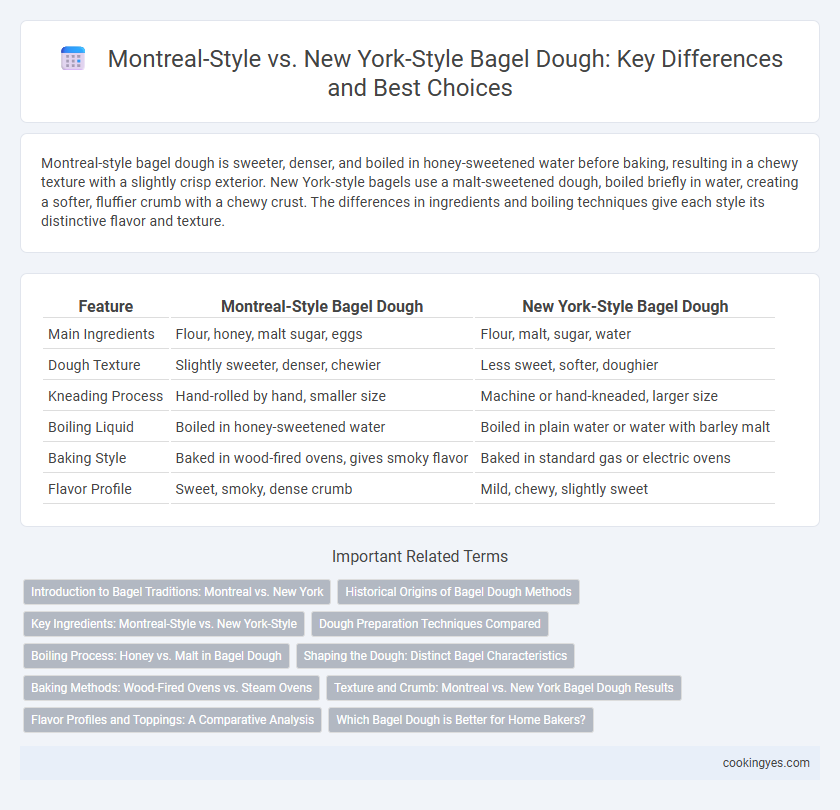Montreal-style bagel dough is sweeter, denser, and boiled in honey-sweetened water before baking, resulting in a chewy texture with a slightly crisp exterior. New York-style bagels use a malt-sweetened dough, boiled briefly in water, creating a softer, fluffier crumb with a chewy crust. The differences in ingredients and boiling techniques give each style its distinctive flavor and texture.
Table of Comparison
| Feature | Montreal-Style Bagel Dough | New York-Style Bagel Dough |
|---|---|---|
| Main Ingredients | Flour, honey, malt sugar, eggs | Flour, malt, sugar, water |
| Dough Texture | Slightly sweeter, denser, chewier | Less sweet, softer, doughier |
| Kneading Process | Hand-rolled by hand, smaller size | Machine or hand-kneaded, larger size |
| Boiling Liquid | Boiled in honey-sweetened water | Boiled in plain water or water with barley malt |
| Baking Style | Baked in wood-fired ovens, gives smoky flavor | Baked in standard gas or electric ovens |
| Flavor Profile | Sweet, smoky, dense crumb | Mild, chewy, slightly sweet |
Introduction to Bagel Traditions: Montreal vs. New York
Montreal-style bagels are characterized by a denser, sweeter dough boiled in honey-infused water before baking in wood-fired ovens, resulting in a chewier texture and distinctive caramelized crust. New York-style bagels feature a larger, softer crumb with a slightly salty flavor, boiled briefly in plain water and baked in conventional ovens for a fluffier interior. These regional differences reflect unique cultural baking techniques that continue to define the iconic Eastern North American bagel traditions.
Historical Origins of Bagel Dough Methods
Montreal-style bagel dough is historically boiled in honey-sweetened water before baking in wood-fired ovens, resulting in a denser, sweeter flavor profile traced back to Eastern European Jewish communities. New York-style bagels use a malt-sweetened water boil and are baked in standard ovens, creating a chewier texture and subtle sweetness rooted in Ashkenazi Jewish immigrant traditions. These distinct boiling and baking techniques reflect the cultural and regional differences that shaped their respective dough methods.
Key Ingredients: Montreal-Style vs. New York-Style
Montreal-style bagel dough uses malt and honey for a sweeter flavor and is boiled in honey-sweetened water before baking, resulting in a denser, chewier texture. New York-style bagel dough typically includes malt and sugar, is boiled in plain water, and produces a softer, fluffier interior with a subtle sweetness. The choice of sweeteners and boiling liquids significantly impacts the bagel's crust crispness and overall taste profile.
Dough Preparation Techniques Compared
Montreal-style bagel dough is sweetened with malt syrup and includes eggs, creating a denser, chewier texture, while New York-style uses a leaner dough with high-gluten flour, resulting in a fluffier interior. Montreal bagels are boiled in honey-sweetened water before baking, enhancing caramelization and a glossy crust, whereas New York bagels are boiled in plain water, producing a softer crust. The combination of malt syrup, egg enrichment, and honey boiling distinguishes Montreal-style dough preparation from New York's simpler technique.
Boiling Process: Honey vs. Malt in Bagel Dough
Montreal-style bagels are boiled in a honey-sweetened water bath, which gives the dough a slightly sweeter flavor and a distinctive golden crust. New York-style bagels use malt syrup in the boiling water, enhancing the dough's maltiness and contributing to a denser, chewier texture. The choice between honey and malt directly influences the bagel's taste profile and crust characteristics, with honey yielding a sweeter and lighter crust compared to the richer, more robust flavor imparted by malt.
Shaping the Dough: Distinct Bagel Characteristics
Montreal-style bagel dough is hand-rolled into a thinner, smaller ring, contributing to its denser and chewier texture. New York-style bagels are shaped into thicker rings with larger holes, resulting in a fluffier interior and a slightly crispy crust. The shaping technique directly influences the bagel's final texture and bite, defining the distinct characteristics of each style.
Baking Methods: Wood-Fired Ovens vs. Steam Ovens
Montreal-style bagels are baked in wood-fired ovens, which impart a distinct smoky flavor and create a denser, chewier texture with a slightly crisp exterior. New York-style bagels are typically baked in steam ovens, producing a softer crust and fluffier interior due to the moist heat that helps retain dough moisture during baking. The choice of oven directly influences the bagel's texture and flavor profile, distinguishing the iconic styles.
Texture and Crumb: Montreal vs. New York Bagel Dough Results
Montreal-style bagels are denser and chewier with a slightly sweeter taste due to boiling in honey-infused water, resulting in a tighter crumb and a crispier crust. New York-style bagels have a fluffier interior and softer crust, achieved by boiling in plain water and using a higher hydration dough that creates a more open crumb structure. The distinct boiling methods and dough hydration levels primarily contribute to the contrast in texture and crumb between Montreal and New York bagel dough.
Flavor Profiles and Toppings: A Comparative Analysis
Montreal-style bagels feature a denser, slightly sweeter dough boiled in honey-sweetened water, imparting a caramelized crust and rich flavor, often topped with sesame or poppy seeds. New York-style bagels have a softer, chewier texture from boiling in plain water and baking longer, with a mild savory profile typically enhanced by toppings like salt, garlic, or onion. The distinct boiling methods and dough formulations create unique taste experiences, with Montreal bagels favoring sweetness and crispness, while New York bagels emphasize chewiness and saltier flavors.
Which Bagel Dough is Better for Home Bakers?
Montreal-style bagel dough is denser and sweeter due to the addition of malt and honey, making it easier to handle for home bakers seeking a chewy texture without extensive proofing. New York-style dough relies on high gluten flour and longer fermentation, resulting in a lighter, airier bagel but requiring more precise timing and skill. Home bakers often prefer Montreal-style for its straightforward recipe and forgiving dough characteristics, allowing consistent results with fewer specialized techniques.
Montreal-style vs New York-style for bagel dough Infographic

 cookingyes.com
cookingyes.com